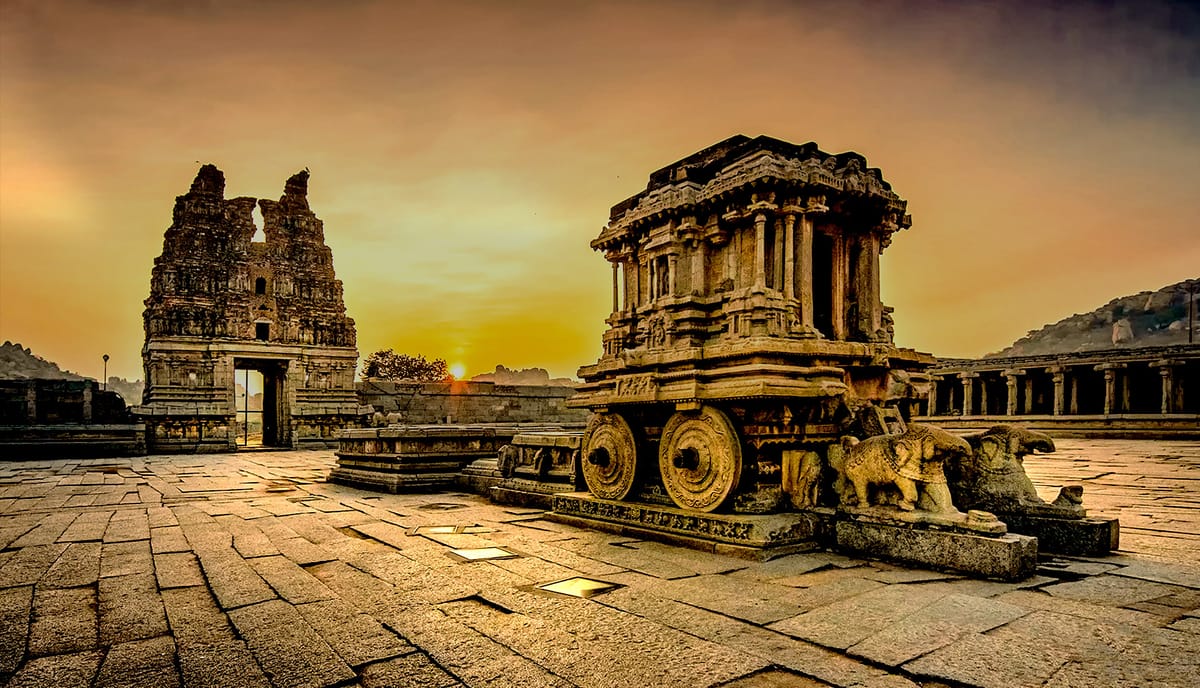Hampi: A Journey Through Time and Grandeur

Nestled amidst the rugged terrain of northern Karnataka, India, lies Hampi, a UNESCO World Heritage Site that serves as a testament to the grandeur and opulence of the Vijayanagara Empire. Steeped in history, adorned with magnificent ruins, and surrounded by breathtaking landscapes, Hampi offers visitors a journey through time, unraveling the mysteries of a bygone era.
Historical Background
Hampi, formerly known as Vijayanagara, was the capital city of the mighty Vijayanagara Empire, which flourished from the 14th to the 16th century. Founded by Harihara I and Bukka Raya I in 1336, the empire reached its zenith under the rule of Krishnadevaraya. Hampi served as the epicenter of trade, culture, and power, attracting merchants, scholars, and artisans from across the world.
The city's prosperity and architectural splendor earned it the title of "City of Victory" (Vijayanagara) and made it one of the richest and most powerful empires of its time. However, Hampi's glory was short-lived, as it fell to the combined forces of the Deccan Sultanates in 1565, marking the end of an illustrious era.
Architectural Marvels
The ruins of Hampi span over 4,100 hectares and comprise more than 1,600 surviving remains, including temples, palaces, markets, and fortifications. The architectural style of Hampi is a unique blend of Dravidian and Indo-Islamic influences, characterized by towering gopurams (entrance towers), ornate carvings, and majestic courtyards.
One of the most iconic landmarks of Hampi is the Virupaksha Temple, dedicated to Lord Shiva. Dating back to the 7th century, this temple is the oldest and most significant religious structure in the region, serving as the focal point of worship and pilgrimage for centuries. The temple's 50-meter-tall gopuram, adorned with intricate sculptures and friezes, is a sight to behold.
Other notable attractions include the Vittala Temple, renowned for its musical pillars and stone chariot; the Lotus Mahal, a graceful pavilion with lotus-shaped domes; and the Hampi Bazaar, a bustling marketplace that once teemed with merchants and traders.
Cultural Heritage
Hampi's cultural heritage is as rich and diverse as its architectural legacy. The city's ruins bear witness to the confluence of Hindu and Islamic traditions, as well as the influences of various dynasties and civilizations that once thrived here. Hampi's temples, sculptures, and inscriptions provide valuable insights into the religious practices, artistic achievements, and social customs of the Vijayanagara period.
The annual Hampi Utsav, a cultural extravaganza held in November, celebrates the city's vibrant heritage through music, dance, drama, and art. The festival attracts artists, performers, and enthusiasts from all over the country, fostering a sense of pride and appreciation for Hampi's cultural legacy.
Natural Beauty
Beyond its historical and cultural treasures, Hampi is blessed with breathtaking natural beauty, characterized by rocky hills, lush vegetation, and meandering rivers. The Tungabhadra River, which flows through the heart of the city, adds to its scenic charm, providing opportunities for boating, picnicking, and leisurely strolls along its banks.
The surrounding landscape of Hampi is dotted with verdant rice fields, coconut groves, and banana plantations, creating a picturesque backdrop for exploration and adventure. Visitors can trek to nearby viewpoints such as Matanga Hill or Anjaneya Hill to witness panoramic views of Hampi's ruins and the surrounding countryside.
Preserving Hampi's Legacy
Preserving and safeguarding Hampi's legacy is a collective responsibility shared by government authorities, heritage organizations, and local communities. Efforts are underway to conserve and restore the city's monuments, protect its archaeological sites, and promote sustainable tourism practices that respect Hampi's cultural and environmental heritage.

Visitors are encouraged to tread lightly, respect historical artifacts, and contribute to the preservation efforts by adhering to responsible tourism guidelines. By appreciating and safeguarding the treasures of Hampi, we ensure that future generations can continue to marvel at its timeless grandeur and draw inspiration from its rich heritage.
Conclusion
Hampi stands as a living testament to the triumphs and tribulations of the Vijayanagara Empire, encapsulating centuries of history, culture, and architectural excellence. Its magnificent ruins, awe-inspiring temples, and picturesque landscapes offer a glimpse into a glorious past and inspire awe and wonder in all who visit. As we explore the remnants of this once-great city, we are reminded of the enduring legacy of Hampi and the enduring spirit of human creativity and resilience.



